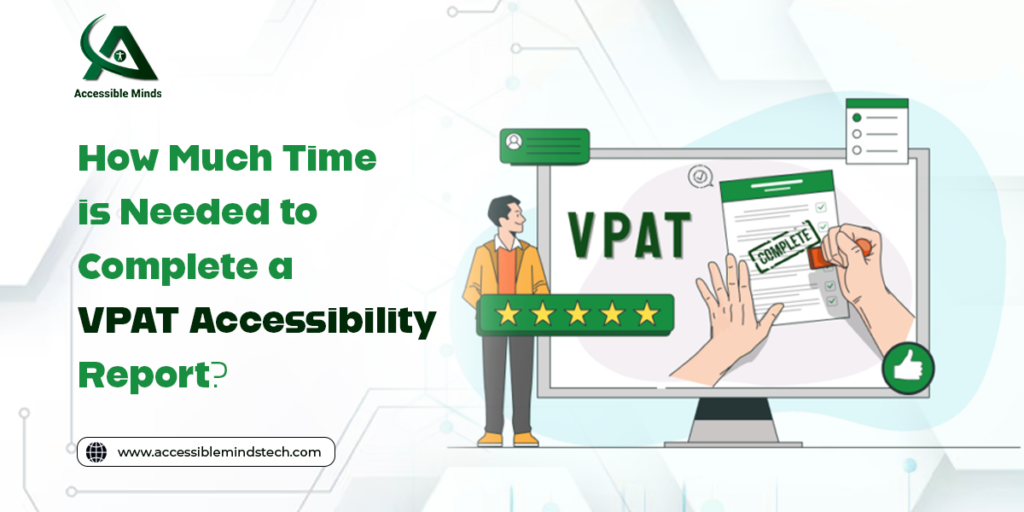When organizations strive to meet accessibility standards for their digital products, completing a Voluntary Product Accessibility Template (VPAT) report is a critical step. A VPAT not only demonstrates compliance with accessibility standards like WCAG, Section 508, and EN 301 549 but also enhances customer trust and market credibility. However, one pressing question organizations often grapple with is: How much time does it take to complete a VPAT report?
In this blog, we’ll explore the key factors influencing the time required to complete a VPAT report and offer insights into how Accessibility Testing Services can streamline the process.
Understanding VPAT and Its Components
A VPAT is a standardized document that outlines how a digital product or service complies with accessibility standards. The process involves:
- Testing and Assessment
Comprehensive testing of the product against relevant guidelines such as WCAG 2.1, Section 508, or the European EN 301 549 standard. - Documentation
Accurately documenting the findings and detailing how the product aligns with each accessibility criterion. - Remediation (if needed)
Addressing any non-conformities identified during the testing phase. - Review and Approval
Finalizing the report and obtaining approval from stakeholders.
The time needed for these steps varies depending on several factors, discussed below.
Factors Influencing the Time Required
1. Complexity and Size of the Product
The scope of the VPAT report is directly proportional to the size and complexity of the product.
- Websites: A simple website with a few static pages may take less time compared to a feature-rich e-commerce site or a web application.
- Mobile Apps: Apps with intricate workflows, animations, or integrations with third-party systems require more in-depth testing.
- Software or Platforms: Enterprise-grade solutions often demand extensive testing across multiple modules.
Estimated Time Impact: Small websites might take around 1 week, while complex products may extend up to 2 weeks. The time frame is for writing the VPAT and does not include testing time frame.
2. Level of Accessibility Compliance
The current state of accessibility plays a significant role.
- Well-maintained Products: If accessibility has been prioritized during the development cycle, fewer issues will need remediation.
- Accessibility Gaps: Products with significant gaps may require additional testing and fixes, extending the timeline.
Pro Tip: Investing in Accessibility Testing Services during development can reduce remediation efforts later.
3. Standards and Guidelines Being Tested
Different accessibility standards have varying requirements.
- WCAG (Web Content Accessibility Guidelines): Focused on web content, WCAG compliance can vary based on the desired conformance level (A, AA, or AAA).
- Section 508: Primarily for U.S. federal agencies, it has specific criteria for ICT (Information and Communication Technology).
- EN 301 549: Widely used in the EU, it emphasizes both web and non-web ICT accessibility.
Each standard’s scope impacts the duration of testing and reporting.
Estimated Time Impact: Testing against a single standard typically takes less time compared to a multi-standard assessment.
4. Team Expertise and Tools
The proficiency of the team conducting the VPAT analysis can significantly influence the timeline.
- Manual Testing Expertise: Accessibility testing often involves manually evaluating elements like keyboard navigation, screen reader compatibility, and color contrast.
- Automated Tools: Tools like Axe, Wave, and JAWS speed up the process but cannot entirely replace manual assessment.
Why Accessibility Testing Services Help: Professional teams combine manual testing expertise with automation tools to ensure comprehensive coverage, saving time and effort.
5. Availability of Stakeholders
Timely input and approvals from product owners, developers, and designers are essential for an efficient VPAT process. Delays in gathering feedback or resolving ambiguities can slow progress.
Best Practice: Establish clear communication channels and schedules to minimize delays.
How Accessibility Testing Services Streamline the Process
Accessibility Testing Services offer tailored solutions to expedite VPAT reporting:
- Comprehensive Assessments: Experienced teams conduct both automated and manual testing to ensure all accessibility aspects are covered.
- Detailed Documentation: Expertly crafted VPAT reports save time in review cycles.
- Remediation Support: Quick fixes for common accessibility issues shorten the remediation phase.
- Continuous Support: Guidance for maintaining accessibility over time.
Tips to Reduce VPAT Reporting Time
- Plan Early: Integrate accessibility testing early in the development lifecycle to minimize last-minute surprises.
- Leverage Professional Services: Partnering with Accessibility Testing Services ensures accuracy and efficiency.
- Prioritize Remediation: Address high-priority issues first to expedite compliance.
- Use Automation Wisely: Automate repetitive tasks while relying on manual expertise for nuanced evaluations.
Conclusion
The time required to complete a VPAT accessibility report varies based on factors like product complexity, compliance level, and team expertise. On average, the process can take anywhere from 2 to 8 weeks. Partnering with expert Accessibility Testing Services not only streamlines the process but also ensures a comprehensive and accurate report, helping your product stand out in the accessibility market.
By investing in the right tools and professional expertise, you can confidently deliver products that meet global accessibility standards and cater to a diverse user base.

